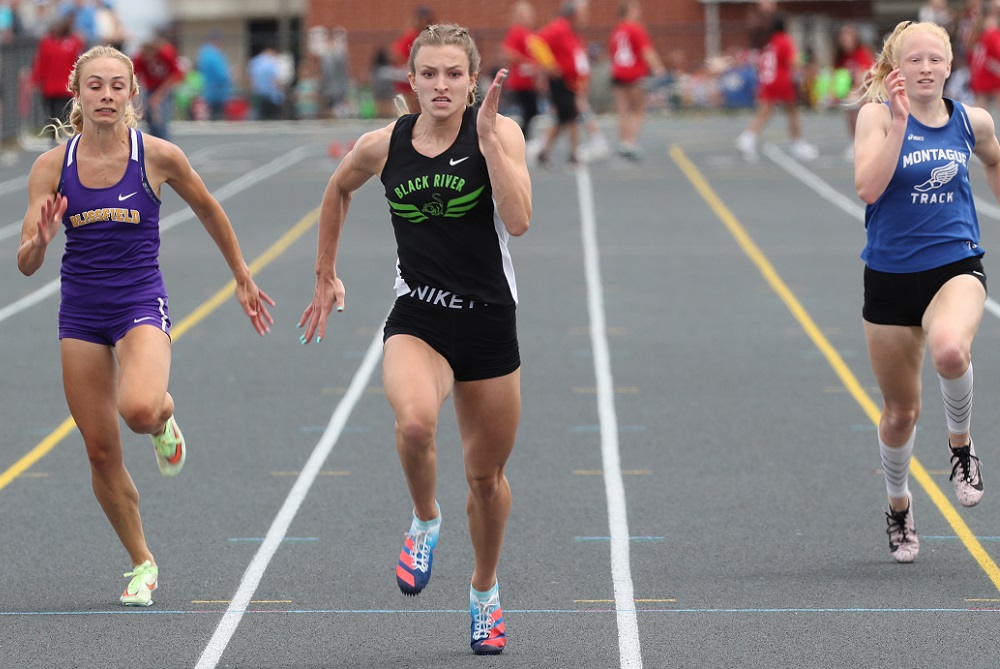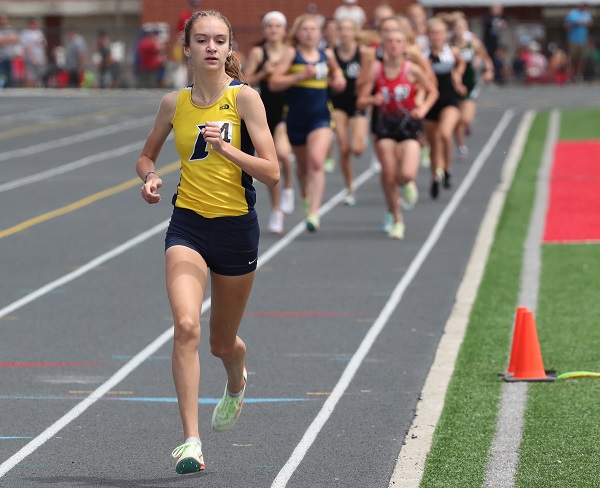
Future Rivals Shine at Kent City, Hart Beats All for 2nd Finals Win
By
Scott DeCamp
Special for MHSAA.com
June 5, 2022
KENT CITY – Kylee Poulton and Lani Bloom are small-school standouts headed for the big time of Division I track & field in the Big Ten Conference.
They showed why at Saturday’s MHSAA Lower Peninsula Division 3 Finals at Kent City High School. They’re about to be arch-rivals in college, too.
Poulton, a Holland Black River senior signed with Indiana University, sprinted to individual titles in the 100-meter dash (12.28 seconds) and 200 (24.83). Bloom, an Ithaca senior signed with Purdue University, ran away with championships in the 800 (2:11.86) and 1,600 (4:49.60). Both runners also anchored relays for their respective teams.
Cross country power Hart was a landslide winner of the team Finals title, the Pirates’ second overall and first since 2018, as they totaled 63 points – 24 more than runner-up Pewamo-Westphalia. Onsted was third (33), Montague fourth (29) and Quincy fifth (28).
“You know, it’s been fun. I know when I started coaching back in ’98 for Hart, they needed somebody and it kind of just grew into a passion. I love coaching – I like teaching school, but I love coaching, too,” said Hart girls track coach Calvin Ackley, who is an assistant for the Pirates’ girls cross country program that’s a five-time reigning champ in LP Division 3.
“It’s fun. It’s fun just to put Hart on the map a little bit in one small aspect of life. … If you’re going to do something, do it all-out, you know.”
All-out is exactly the way Poulton and Bloom performed Saturday.
For Poulton, those were her first two Finals championships. She had the best time of all qualifiers in the 400 but decided not to run that event because she wanted to conserve energy for the 200. Last year, she was LPD3 runner-up in the 100, third in the 200 and fourth in the 400.
Poulton ran the anchor leg on Black River’s 1,600 relay team to close the day Saturday. That quartet did not place, but she still enjoyed herself.
 “This year was really fun. I really love my team this year,” said Poulton, who ran into a bit of a headwind Saturday but still felt strong. “Having a 4x4 relay has been, like, a highlight because it’s just so fun.
“This year was really fun. I really love my team this year,” said Poulton, who ran into a bit of a headwind Saturday but still felt strong. “Having a 4x4 relay has been, like, a highlight because it’s just so fun.
“In the past years, I wasn’t able to participate in relays, but we were able to put together a pretty good team this year and run in the state finals. I’d say my highlight would be the Regional meet. We were last (in the 1,600 relay) and then we ended up becoming first (at the Regional).”
Bloom is no stranger to MHSAA Finals championships. She also won 800 and 1,600 titles at last year’s Finals, plus she captured an LP Division 3 cross country championship in the fall.
Bloom anchored Ithaca’s 3,200 relay team that placed fourth.
“I was really nervous going into (Saturday’s meet) because I haven’t really had a lot of races where I had to have that get-up-and-go mindset where I had to, like, actually race my hardest, dive over the line every time,” she said. “It was a challenge for me today, but I feel like I really rose to the occasion and I’m really proud of what I did today.”
Other individual champions from Saturday’s LP Division 3 Finals included Onsted’s Emmry Ross in the 400 (57.93), Grand Rapids Covenant Christian’s Meghan Beute in the 3,200 (personal record 10:37.57), Pewamo-Westphalia’s Saige Martin in the 100 hurdles (15.23 PR) and 300 hurdles (46.24 PR), Sand Creek’s Grace Elliott in shot put (40-4.25 PR), Grayling’s Rylan Finstrom in discus (145-2 PR), Lawton’s Heidi Newhouse in high jump (5-5), Grand Rapids West Catholic’s Ally Olszewski in pole vault (11-0 PR) and Benzie Central’s Gloria Stepanovich in long jump (17-4.25).
Two of Montague’s relay teams claimed championships, in the 400 (50.24) and 800 (1:47.10). Ross helped Onsted also win the 1,600 relay (4:06.02), while Hart cruised to victory in the 3,200 (9:30.18).
“I mean, it’s crazy. We just came here with nine girls, and we knew we were seeded decently high. But just to go out here and finally do it has been something that I didn’t expect at the beginning of the season,” Hart senior Kendall Williamson said. “I had no idea we were going to be here.”
PHOTOS (Top) Holland Black River’s Kylee Poulton, middle, sets the pace during one of her sprint championships Saturday at Kent City. (Middle) Ithaca’s Lani Bloom builds a significant lead during one of her victories. (Click for more from Carter Sherline/Run Michigan.)

Track Gaining Speed Toward Future with Electronic Starting Devices
By
Steve Vedder
Special for MHSAA.com
May 23, 2023
Aubrey Greenfield thinks it might be the perfect time to reevaluate 130 years of tradition.
For a number of reasons, from technical to personal, the Oxford senior sprinter believes it makes sense for the crack of a starting pistol to be eliminated from high school track meets.
Because track meets would benefit in various ways from lowering costs to easier setup at meets to the human factor of competitors not having to flinch at the crack of a pistol shot, Greenfield believes the sport has a chance to embrace new technology – electronic starting devices (ESD).
In essence, an ESD replaces the starting pistol with a light flash, tone sound or both to begin a race.
"High school sports should put the athlete first," Greenfield said. "We should promote sports, and eliminating starting pistols promotes health in terms of PTSD or trauma for athletes and spectators and that would be good. I would like to think people would say that's a good idea."
In fact, Greenfield would go as far as to say if there was not an implementation of electronic starting devices, many of her teammates would have considered giving up the sport.
"If it's something that helps us compete safely, we're all for it," she said.
Greenfield's opinion apparently is spreading. Michigan High School Athletic Association senior assistant director Cody Inglis said the use of ESD makes it both affordable for meet starters and sensible for athletes and fans to rethink the use of starting pistols. While the MHSAA is not mandating electronic starting devices, it does promote the use of what Inglis calls "emerging technology." He notes that ESD are becoming the norm for organizations such as USA Track & Field, the NCAA and an increasing number of high schools.
 "I think we have to embrace new technology, and we think this will be something that takes hold," Inglis said.
"I think we have to embrace new technology, and we think this will be something that takes hold," Inglis said.
A key part of embracing ESD is the human element. The tragic Oxford High School shooting Nov. 30, 2021, that took the lives of four students while injuring seven others should not be relived even for a fleeting instance at a high school sporting event. Oxford athletic director Tony DeMare said the school began using ESD at every meet, including the MHSAA Lower Peninsula Division 1 Finals last June. He said that decision was embraced by virtually all schools Oxford encountered.
"We were very convinced that the alternative (of ESD) would promote a healthy attitude," DeMare said. "We were overwhelmed with the positive response. If a school was on the fence about it or might not be for it, I think we've started to see the tide turn in favor of people willing to listen and learn about electronic starting devices."
Inglis said the MHSAA is acutely aware of what the crack of a starting pistol can mean to athletes and fans.
"It's unimaginable what Oxford went through, and this is a small way we can help," he said. "We look at a (starting pistol) and think, ‘Could we do something else?’ It's a way of helping to solve a problem."
Over the last several years, the MHSAA has embraced finding an alternative to starting pistols. Inglis noted the discussion started with the cost and diminishing availability of 32-caliber ammunition that meet starters use. A box of ammunition, if it can be found, is around $75 a box.
In addition to cost, there is potential damage from excessive exposure to 150-plus decibels of sound generated by the traditional 32-caliber blanks. Medical studies show damage to ears caused by decibel levels above 120 dB.
The tragedy at Oxford accelerated the conversation.
Inglis said the cost of ESD can be likened to a school sinking money into artificial surfaces at football fields. Yes, there is a great cost at first, but over time money is ultimately saved. An ESD system itself ranges between $200 and $500. Speakers also may need to be purchased, but with ESD starting events like the 800 and 1,600-meter relays positioned near the outside lanes 8, 7, 6 and 5 would result in improved hearing by athletes at the start of a race.
There is one challenge with ESD that track administrators are working to overcome – lighting conditions that lessen the ability to see the ESD’s LED light or strobe when the button is pressed by a starter to begin a race. But that vision difficulty resulting from clear blue skies and backgrounds of setting suns can be substantially improved by incorporating a black background with an ESD – something as simple as a starter holding up black cardboard behind the lighting mechanism at the start of an event.
Inglis said when all factors are considered, the use of ESD makes sense.
 "With the climate we live in nowadays, no lookalike guns is good," he said. "We're not mandating this. But people are saying this is affordable."
"With the climate we live in nowadays, no lookalike guns is good," he said. "We're not mandating this. But people are saying this is affordable."
While switching to ESD would break 130 years of tradition, the timing could be a step forward, said Jeff Hollobaugh, co-author of the book "The Fleet Feet of Spring: Michigan's High School State Championships in Track & Field." He said while no definitive answer is possible, it's likely starting pistols were used at the inaugural state meet at the Jackson Fairgounds in 1895. The meet, which included events like tossing a 16-pound shot put, bike races and a 100-meter sprint, was sponsored by the Michigan Interscholastic Athletic Association (a predecessor to the MHSAA) and comprised mostly of the state's larger schools.
Hollobaugh's sentiments echo what many involved in today's high school track & field believe in terms of making a transition from starting pistols to electronic starting devices.
"It's a change, not necessarily good or bad, just different," he said. "It's not a drastic change, but it will take some getting used to. But it is the future. In the end, we'll all be fine."
DeMare believes the future of high school track will definitely include ESD.
"Our desire is that the practicality and sensibility of this will overcome the alternative," he said. "I think we'll see the automation and electronics taking hold of certain elements in track, and people will embrace it."
PHOTOS (Top) Runners watch official Bertha Smiley as they prepare to begin a race during last season's Lower Peninsula Division 1 Finals at Rockford. (Middle) An electronic starting device provided by VS Athletics was used to start those races. (Below) Smiley sets to begin an event. (Photos provided by David Kuderka/VS Athletics.)

